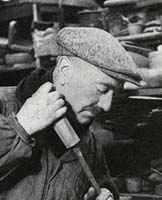
 Alexandre Noll was born in Reims on May 19, 1890, to Alsatian parents. After his secondary education, he worked in weaving in Reims, and, although he always showed a keen interest in drawing, he became a bank employee.
Alexandre Noll was born in Reims on May 19, 1890, to Alsatian parents. After his secondary education, he worked in weaving in Reims, and, although he always showed a keen interest in drawing, he became a bank employee.
His military service was followed by the war, which he spent in the Serbian army, in the East, from where he brought back countless sketches. Upon his return, he began to work with wood, with which engraving had already made him familiar. From 1920 to 1925, he turned umbrella and parasol handles, made engraved lamp bases... But at the same time, his personal research began. At the International Exhibition of 1925, he presented engraved lacquers, then exhibited at the Autumn Salon and the Decorative Artists Salons, and regularly presented his works at "La Cremaillere" since 1927. As early as 1935, his sculptural work was heralded with bowls, trays, and pitchers.
He participated in the 1937 Exhibition, played a significant role in the 1939 Decorators Salon. In 1943, his first pieces of furniture were presented at the French Arts Company. Since 1946, he has exhibited at the New Realities Salons, and the same year at Colette Allendy's.
In 1947, his first individual exhibition took place at the Pyramid, rue d'Artois, with furniture and sculptures; followed by one at La Gentilhommière; in 1950, he took part in the Milan Triennial, the Salon des Artistes Decorateurs, was invited to the exhibition "The Sculpture from Rodin to Our Days", at the Maison de la Pensée Française and, at the Pavillon de Marsan, at the "Table Arts" with significant participation at Jacques Adnet's stand. Finally, since 1950, he has participated in numerous exhibitions abroad: Munich, Madrid, Vienna, London, Varese, etc.
Alexandre Noll made wood his sole medium of expression. Nothing seemed to prepare him for it except for an instinctive understanding. Because he loves wood, is subject to its magnetic power, he respects its elemental force, and gradually his technique and art take on the character of an exclusive cult, involving the hand that carves, sculpts, polishes the wood, and the mind that conceives and organizes forms.
To achieve the daring freedom of expression of objects, furniture, and especially sculptures, it was necessary for Noll to reach this virtuosity, a means and not an end, which made him master of the material. The obscure works that necessity forced him to undertake at the beginning broke him in all the difficulties. Without any knowledge of the trade or the tools, he slowly apprenticed and thus learned to discover the virtues, beauties, reactions of different types of wood, rustic wood from our orchards or precious from tropical forests.
From then on, he treats them with a kind of fervor made of knowledge and love. The first objects - trays, bowls, pitchers, and even boxes and salt shakers are already potential sculptures and to make his furniture, carved from logs and trays, with organic assemblies, without glue or any addition of metal, inspired by the constructive logic of nature, Noll knows no other laws than complete submission to this force that springs from the earth, whose secret beauty he tirelessly seeks to exalt. Noll's art is both objective and abstract; all his work responds to a spiritual necessity.
It materializes the mysterious paths of a thought haunted by philosophical problems. To express himself, Noll invented signs, rhythms, volumes, contrasts of full and empty spaces, endless scrolls to which the wood lends its formal reality.
Sources : Mobilier et Decoration N° 4 Mai 1954
Also:
Alexandre Noll (1890-1970) was born in the Alsace region of France and was not involved in art until the 1920s. During World War I, he sketched, did watercolors but primarily made woodcuts. After the war was over, he began sculpting, starting with umbrella handles and lamp feet for couturier Paul Poiret.
In 1925 he took part in the International Exhibition of Modern Decorative and Industrial Arts, outlining a series of sculpted objects. In 1935 he began his "furniture sculptures," which were carved into sycamore, mahogany, teak and ebony. He participated in the 1937 International Exhibition of Arts and Techniques, showing a few small pieces. In 1939 he showed at the Salon des Artistes Decorators and the seventh Milan Triennale in 1940.
During World War II, Noll designed furniture and forged his style and was ready to produce his unique furniture by the time the war ended, but by the 1950s, Noll had returned to sculpture and took part in numerous exhibitions in France.
He is known for his natural style, his purity of form and in an approach that was both poetic and philosophically intuitive.